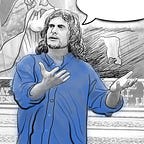Cornplanter O’Bail
The date was August 2nd, 1780 and the Iroquois braves were adorned with black and red war paint while their prisoners trembled and cowered. The guards herded their white captives; men, women, and children, into a huddled mass. Quietly, one of the prisoners, a colonist from upstate New York, spoke to his captors in their own Seneca language. Startled, the warrior ran to get one of the chiefs.
The Seneca tribe was a member of the Iroquois Confederacy, the same Confederacy which helped inspire Ben Franklin and other founding fathers when drawing up the Constitution. The American Revolution would rip apart the League of the Iroquois forever. Some of the Indian nations wanted to side with the colonists while others insisted on allegiance to the British. Most members of the Iroquois, such as Cornplanter O’Bail, favored neutrality.
Cornplanter O’Bail is among the most famous of Seneca chiefs. Cornplanter had a half brother named Handsome Lake who was a chief of the Iroquois Confederacy and went on to become a famous religious leader. Cornplanter’s nephew, Governor Blacksnake was also an Iroquois Confederacy chief. In a letter written to the Governor of Pennsylvania, Cornplanter gave a brief description of his childhood. He commented to his mother that when he played with other Indian boys they remarked on the difference
between his skin color and theirs. His mother, a full blooded Seneca, told her son that his father was a white colonist living near Albany. Conrplanter made a journey to visit his father and was greeted kindly but remarked in his letter to the Pennsylvania governor that he did not tell his son the colonies were about to rebel against England.
As the war began the leadership of the Iroquois Confederacy was devastated by plague, leaving the league of Native American nations without a coherent voice. Debate about the conflict raged. Blacksnake recorded his uncle Cornplanter’s opposition to involvement in the revolutionary war. Cornplanter said “War is war, death is death, and a fight is hard business.” Cornplanter made this short succinct speech to a gathering of tribes. Despite Cornplanter’s appeal, the tribes decided to fight alongside the British. Because of his leadership in the French and Indian Wars, Cornplanter was chosen to be one of the war generals.
On August 2nd, Cornplanter, Joseph Brant, Old Snake, and Fish Carrier led a scorched earth campaign against the Schoharie district of the Mohawk Valley. This native expedition burned two forts, 53 houses and more than 50 0r 60 prisoners were taken. One of the prisoners, a tall sinewy, weather beaten man spoke to his captors in their own Seneca language. An Indian guard ran to fetch Joseph Brant.
Brant, thought he recognized the prisoner. “Are you the white man John O’Bail?”
“I am John O’Bail.” he replied.
“Did you have a wife in the Seneca Castle?”
“I had a Seneca woman but that was a long time ago.”
Cornplanter was brought to address the prisoner.
“”My name is John O’Bail, commonly called Cornplanter. I am your son. You are my father. You are now my prisoner and subject to the customs of Indian warfare; but you shall not be harmed… Have no fear, I am a warrior. Many have I killed, many scalps have I taken. I was anxious to see you, to greet you in friendship… I went your cabin and took you by force but your life was spared. Indians love their friends and kindred, and treat them with kindness. If you do now choose to follow the fortunes of your yellow son, and live with our people, I will cherish you in age with plenty of venison, you shall live at ease. If your choice is to return to your fields, to live with your wife and white children, I will send a party of trusty young men to conduct you safely back. I respect you, my father, you have acted kindly towards the Indians, and they are your friends.”
John O’Bail chose to return to his white family. The American colonists were successful in their revolution and established a new government along the shores of the Atlantic Ocean. Cornplanter helped negotiate the first peace treaty between the native peoples and the new government with its first president George Washington. This Fathers Day story is just meant to illustrate how one son was willing to put aside differences of race, culture and even ignore a war to honor his father. All things considered, perhaps there is a phone call you would like to make.
